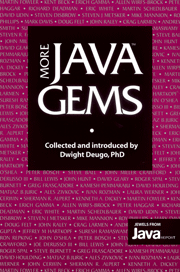Book contents
WHEN IN ROME: A GUIDE TO THE JAVA PARADIGM
Published online by Cambridge University Press: 06 July 2010
Summary
Moving to a new language involves some paradigm shifts in how you think about structuring programs and solving problems. Often we think in terms of solutions instead of problems and so ask questions like, “How do I pass a method pointer Java?” instead of “How do I encapsulate a behavior reference in Java?” This is particularly important for C++ programmers migrating to Java, because the similarity in syntax between the languages can lead to the assumption that the language paradigm is identical.
I'll discuss two classes of problems faced by developers. The first is what I call “Conceptual Confusion,” where a user of one language carries their assumptions to another language and then gets confused when their assumptions are invalid. The second class is the desire for new features to be added to the language. This “Creeping Featurism” generally involves adding complexity to the language for the sake of mimicking another language's feature, often no more than syntactic sugar. That is, the proposed feature may reduce the typing without adding to the power of the language.
Let me warn you of my bias: I find that too many features in a language confuse me. I find that a simple language based on a single paradigm provides for less confusion, better maintainability, and quicker code development. You may understand that neat “constant reference” feature, but think of the person who may have to fix, reuse, or extend your code a year from now.
- Type
- Chapter
- Information
- More Java Gems , pp. 3 - 14Publisher: Cambridge University PressPrint publication year: 2000



